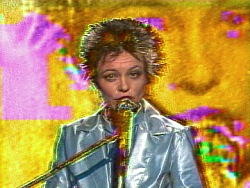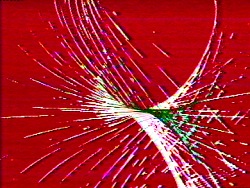
MAGNETIC MEMORY:
A Day-Long Video Tribute to Nam June Paik
MAGNETIC MEMORY:
A Day-Long Video Tribute to Nam June Paik
535 West 22nd Street, 5th Floor, New York City
MAGNETIC MEMORY:
A Day-Long Video Tribute to Nam June Paik
535 West 22nd Street, 5th Floor, New York City
MAGNETIC MEMORY:
A Day-Long Video Tribute to Nam June Paik
535 West 22nd Street, 5th Floor, New York City
Works
Nam June Paik's first single-channel videotape since 1989 is a heartfelt tribute to his long-time collaborator Charlotte Moorman. This portrait traces Moorman's career as an avant-garde performer, from her classical training to her notorious arrest as the "Topless Cellist" and subsequent...
9/23/69: Experiment with David Atwood
Nam June Paik. In collaboration with David Atwood, Fred Barzyk, and Olivia Tappan.
1969, 80 min, color, sound
9/23/69 is a newly restored treasure. This early masterwork of electronic experimentation was created by Paik while he was Artist-in-Residence at WGBH in Boston. The title refers to the day it was made — September 23, 1969. Paik creates a stunning visual collage that fuses spontaneous, free-form...
Television on speed, Nam June Paik's A Tale of Two Cities is a potpourri of pop personalities, avant-garde antics and international cultural kitsch, where past, present and future collide in the kaleidoscopic, hyper-kinetic, televisually "now."
A Tribute to John Cage is Paik's homage to avant-garde composer John Cage. A major figure in contemporary art and music, Cage was one of the primary influences on Paik's work, as well as his friend and frequent collaborator. In this multifaceted portrait, Paik creates a pastiche of Cage's...
In Allan 'n' Allen's Complaint, the influence of Jewish fathers on their sons and the complexity of familial relationships are explored in a witty, poignant portrait of two artists. Beat poet Allen Ginsberg (whose father Louis was a poet in his own right) and performance artist/sculptor Allan...
Drawing from Paik's earliest experiments with video synthesizers, Analogue Assemblage employs current technology to create a multilayered montage that references both the old and the new. An eerie electronic score from 1969 floats over ghostly processed images; the result is a paean to the way the future was.
Beatles Electroniques
Nam June Paik and Jud Yalkut
1966-72, 1992, 2:59 min, color, sound, 16 mm film on video
Part of a collection of restored early works by Nam June Paik, the haunting Beatles Electronique reveals Paik's engagement with manipulation of pop icons and electronic images. Snippets of footage from A Hard Day's Night are countered with Paik's early electronic processing.
The exuberant irreverence and wit of Butterfly characterizes Paik's stream-of-consciousness visual and conceptual techniques. In a vibrant image/music collage, he ironically juxtaposes high-cultural artifacts (the aria from Madame Butterfly), contemporary avant-garde icons (Laurie Anderson) and...
Button Happening is Nam June Paik's earliest extant videotape, and possibly his first tape ever. Recorded in 1965 on the day he acquired his first Sony Portapak camera, this previously unknown work has recently been rediscovered and restored. Recorded on computer tape, this technically fragile...
Cinéma Metaphysique: Nos. 2, 3 and 4
Nam June Paik and Jud Yalkut
1967-72, 8:39 min, b&w, sound, 16 mm film on video
This early work belongs in the company of Paik and Yalkut's classic collaborative "video-films." To the accompaniment of the abrupt sonic interjections of Fluxus-affiliated composer Takehisa Kosugi, Yalkut's film records brief, masked views of human actions. Reminiscent of Beckett's theater, as well as the minimal movements of 1960s avant-garde dance, Cinéma Metaphysique is a study in gesture and stillness, noise and silence.
Using Bell Lab's pioneering research facilities, Paik creates a starkly minimal experiment in computer imaging, in which a shifting dot appears on a black ground. A. Michael Noll, a researcher and Professor Emeritus at the Annenberg School for Communication & Journalism at the University of...
Documenta 6 Satellite Telecast
Joseph Beuys, Douglas Davis, and Nam June Paik
1977, 30 min, color, sound
Documenta, held every five years in Kassel,Germany, is one of the largest and most important contemporary art surveys. In 1977, Documenta 6 featured the first live international satellite telecast by artists. Performances by Nam June Paik, German conceptual artist Joseph Beuys, and Douglas...
Early Color TV Manipulations by Nam June Paik
Nam June Paik and Jud Yalkut
1965-68, 5:18 min, color, silent, 16 mm film on video
Marked by a playful, irreverent sense of improvisation and experimentation, these experiments with image manipulation and synthesis form a link between Paik's performance and sculptural works of the 1950s and early 1960s and the celebrated video works and installations of his later years.
Electronic Fables
Nam June Paik and Jud Yalkut
1965-71, 1992, 10 min, color, sound, 16 mm film on video
Electronic Fables is an example of Paik's early improvisations and experiments with electronic image manipulation, prior to his invention of the Paik/Abe Video Synthesizer. This piece also makes use of anecdotes by John Cage and other influential artists and cultural figures.
Electronic Moon No. 2
Nam June Paik and Jud Yalkut
1966-72, 1992, 4:52 min, color, sound, 16 mm film on video
The Medium is the Medium is one of the earliest and most prescient examples of the collaboration between public television and the emerging field of video art in the United States. WGBH-TV in Boston commissioned six visual artists -- Allan Kaprow, Nam June Paik, Otto Piene, James Seawright,...
Electronic Yoga
Nam June Paik and Jud Yalkut
1966-72, 1992, 8:18 min, color, sound, 16 mm film on video
Global Groove is a seminal work in the history of video art. Paik's radical manifesto on global communications in a media-saturated world is rendered as an electronic collage, a sound and image pastiche that subverts the very language of television. With surreal visual wit and an antic neo-Dada sensibility, Paik brings together a cross-cultural melange of artworld figures and Pop iconography.
Good Morning Mr.Orwell is an edited version of Paik's first international satellite "installation," which was held on New Year's Day 1984. Paik's transcultural satellite extravaganzas link different countries, spaces, and times in often chaotic but entertaining collages of art and pop culture,...
Guadalcanal Requiem
Nam June Paik with Charlotte Moorman
1977, re-edited 1979, 28:33 min, color, sound
One of Paik's most overtly political and poignant statements, Guadalcanal Requiem is a performance/documentary collage that confronts history, time, cultural memory and mythology on the site of one of World War II's most devastating battles. Guadalcanal in the Solomon Islands is the iconic...
Paik produced this exuberant, high-speed collage as a commission for the National Fine Arts Committee of the 1980 Olympic Winter Games. In a fractured explosion of densely layered movement and action, images of Olympic sports events are mixed with Paik's recurring visual and audio motifs: the...
Living with the Living Theatre
Nam June Paik with Betsy Connors and Paul Garrin.
1989, 28:30 min, color, sound
One of Paik's most compelling and poignant tapes, Living with the Living Theatre pays tribute to Judith Malina and the late Julien Beck, founder of the Living Theatre. Reversing the theme of the earlier Allan 'n' Allen's Complaint, which dealt with two artists and their relationships to their...
MAJORCA - fantasia
Nam June Paik in collaboration with Paul Garrin and Amy Greenfield
1989, 4:52 min, color, sound
MAJORCA-fantasia is a densely textured collage of often discordant, often beautiful visual and aural elements. To an exquisite musical composition by Chopin, as interpreted by Charlie Morrow, Paik and Garrin create a surreal pastiche of fragmented, manipulated elements: The late ...
Media Shuttle: Moscow/New York
Dimitri Devyatkin and Nam June Paik.
1978, 28:11 min, b&w and color, sound
"What would happen if the people of New York and Moscow had a kind of citizen's band television, could see and talk with each other via satellite? The idea of a 'Media Shuttle' evoked this science fiction fantasy." So begins Media Shuttle: Moscow/New York, in which Devyatkin and Paik create a...
Merce by Merce by Paik Part One: Blue Studio: Five Segments
Merce Cunningham and Charles Atlas
1975-76, 15:38 min, color, sound
Blue Studio: Five Segments is a groundbreaking work of videodance by postmodern master Merce Cunningham and his then filmmaker-in-residence, Charles Atlas. In a series of short pieces choreographed and performed specifically for video space, Cunningham is multiplied, overlaid and transported from the studio to a series of unexpected landscapes. Cunningham's gestural dance is manipulated to the accompaniment of a disjunctive audio collage that includes the voices of John Cage and Jasper Johns.
My Mix '81 merges excerpts from earlier Paik works, including Lake Placid '80, Suite 212, and Electronic Opera No. 2, with an interview of the artist by Esther Schwartz Harriot. Taped in his New York loft, Paik brings his characteristically elliptical and humorous approach to a discussion of the...
Produced for public television station WNET/Thirteen in New York, Nam June Paik: Edited for Television is a provocative portrait of the artist, his work and philosophies. This fascinating document features an interview of Paik by art critic Calvin Tompkins (who wrote a New Yorker profile of the...
Suite 212
Nam June Paik. In collaboration with Douglas Davis, Jud Yalkut, and Shigeko Kubota.
1975, re-edited 1977, 30:23 min, color, sound
Suite 212 is Paik's "personal New York sketchbook," an electronic collage that presents multiple perspectives of New York's media landscape as a fragmented tour of the city. Opening with the 1972 work The Selling of New York, a series of short segments designed for WNET's late-night television...
Tiger Lives is a re-edited compendium of footage from Paik's classic videotapes, re-assembled in 1999 with new material and vivid electronic processing. Commissioned for broadcast on Korean television as part of Korea's Millennium celebration, Tiger Lives presents a flow of images and scenarios...
TV Cello Premiere is a silent film documentation of Charlotte Moorman in her first performance on Paik's eponymous TV Cello at the Bonino Gallery in New York in 1971.
Video Commune (Beatles Beginning to End)
Nam June Paik and Jud Yalkut
1970-92, 8:36 min, color, silent, 16 mm film on video
Video Commune is Jud Yalkut's free-form documentation of Nam June Paik's first interactive television "performance" at the public television station WGBH in Boston. Subtitled "Beatles from Beginning to End," this was a live broadcast in which Paik created a freewheeling collage of recorded images, image-processing and Beatles music.
Video Tape Study No. 3
Nam June Paik and Jud Yalkut
1967-69, 1992, 4:01 min, b&w, sound, 16 mm film on video
Part of a collection of restored early works by Nam June Paik and Jud Yalkut, this piece is historically significant as well as remarkably prescient. Video Tape Study No.3 is a direct media intervention, in which Paik distorts and manipulates footage from news conferences by U.S. President Lyndon...
In Vusac — NY, Paik continues his postmodern project of recontextualizing footage from his earlier tapes, updating and transforming familiar images. This collaborative pastiche merges Paul Garrin's reprocessing of the 1975 Suite 212 with Betsy Connor's clay-animation "interludes." New York is...
Waiting for Commercials
Nam June Paik and Jud Yalkut
1966-72, 1992, 6:41 min, color, sound, 16 mm film on video
Part of a restored collection of rare early works by Nam June Paik, Waiting for Commercials is a hilarious compendium of Japanese TV commercials. This early example of Paik's use of appropriated television imagery as pop cultural artifact was originally created for a performance piece of the same name, which featured Charlotte Moorman and her cello.
A collaboration with the late art critic Gregory Battcock, You Can't Lick Stamps in China begins as a witty travelogue that explores the position of the Western tourist in relation to other cultural contexts. Created for the Visa series, which was conceived by Paik to highlight artistic/cultural...





































